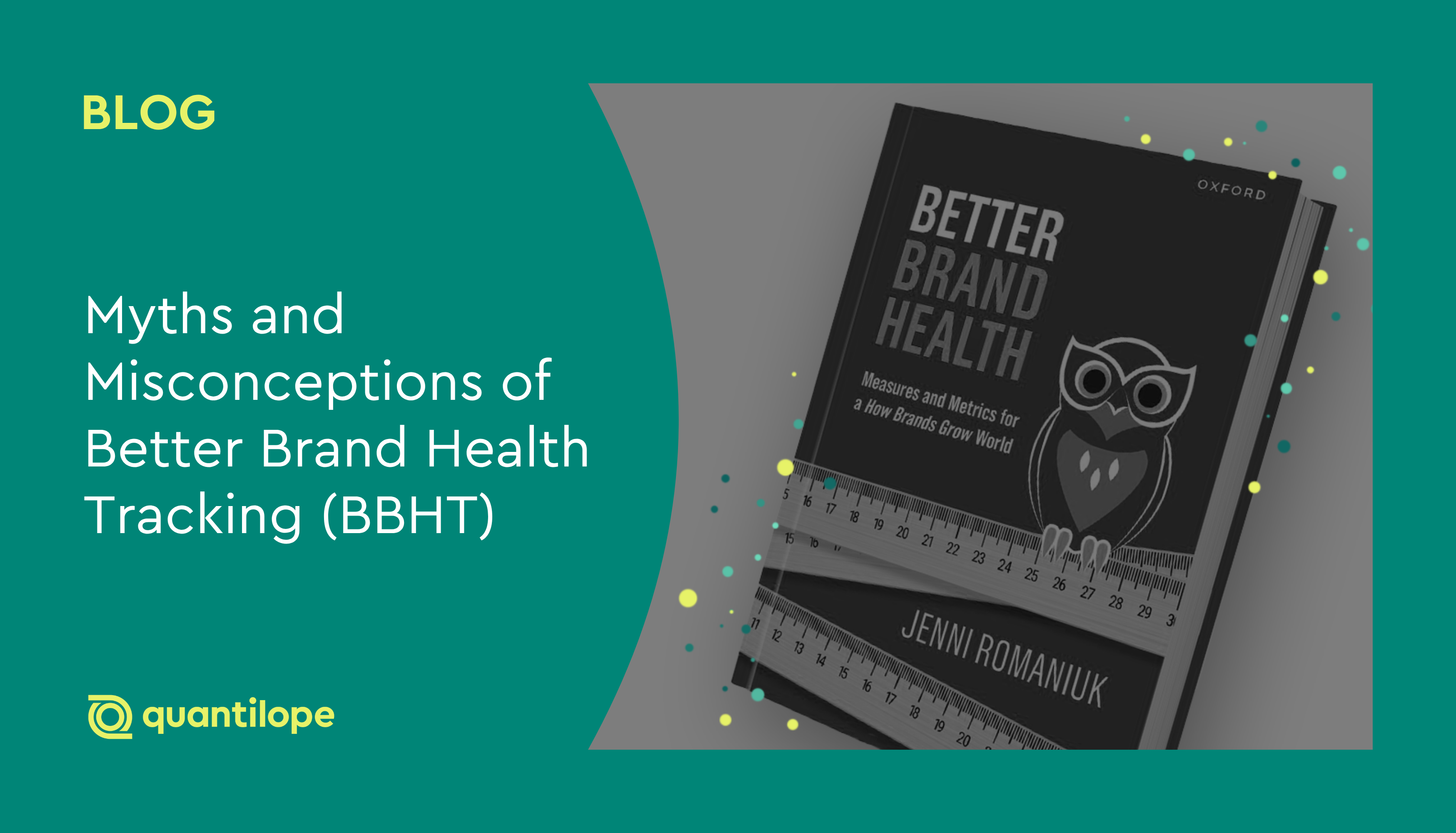This article is for market researchers, brand managers, and marketing executives who are interested in learning more about BBHT, what it offers, the problems it solves, and common myths surrounding it.
Brands looking to understand their performance and competitive standing over time have traditionally leaned on the brand funnel - that is, brand awareness, consideration, and usage. These funnel metrics are great indicators of brand health, but over time, market research experts began realizing there was crucial information missing from these traditional brand health trackers. Brands need to know not just what consumers think about their brand and if they’re buying it; they need to know what’s bringing consumers to shop in their category in the first place. After all, consumers who aren’t shopping in your category are not shopping for your brand.
Table of Contents:
-
Myth 1: BBHT is just another name for traditional brand health tracking
-
Myth 3: BBHT is too difficult or time-consuming to implement
-
Myth 4: A single metric, like NPS, is enough to track brand health
The comfort of the brand funnel
The traditional funnel approach assumes a rational, step-by-step process that doesn't account for the quick, often subconscious decisions consumers make while shopping. For instance, a person who is "aware" of a brand but has no mental connection to it in a particular buying situation will likely not buy it (i.e. if someone is aware of the brand Puma but doesn’t think of Puma when heading out to buy back-to-school shoes for their kids, they’re likely not going to look for that brand. They may instead look for the brands that are mentally ‘present’ like Nike, Adidas, or New Balance).
Better Brand Health Tracking (BBHT) is the answer to those missing nuances and mental connections. Yet, those who have relied on traditional brand trackers (or worse - gut feel!) for as long as they’ve been running market research initiatives are still hesitant to make the shift. Below we'll explore some common myths and misconceptions surrounding BBHT - the empirically-grounded approach from Professor Jenni Romaniuk’s decades of academic research and practical industry experience at The Ehrenberg-Bass Institute (EBI) for Marketing Science.
Back to Table of Contents
Myth 1: BBHT is just another name for traditional brand health tracking
This is perhaps the most significant misconception. While both BBHT and traditional brand health tracking aim to measure brand health (as their names aptly imply), their methodologies and metrics are fundamentally different - as are their data outputs.
The traditional approach: The brand funnel
Traditional brand health tracking studies rely heavily on the "brand funnel," which captures the following brand health metrics:
-
Awareness: Do consumers know about your brand?
-
Consideration: Do they consider buying your brand?
-
Purchase/Usage: Do they buy your brand? What’s your brand usage?
-
Loyalty: Do they remain loyal to your brand over time?
While these funnel metrics provide helpful key takeaways, they don’t provide insights into why the metrics are at certain levels, or - more importantly, how to improve them (i.e. do we ramp up our marketing strategies? redesign our brand assets? invest in new products or partnerships?). That's where BBHT stands out, as an approach that leaves brands with actionable next steps.
The BBHT approach: Category Entry Points → Mental Availability
Unlike traditional brand health tracking which captures individual tracking metrics, BBHT is built around a central Category Entry Point framework. Category Entry Points (CEPs) are the ‘cues’ that prompt consumers to go out and shop in a particular category (e.g., "for a quick lunch" or "when celebrating a special occasion"). Brands create this list of potential CEPs to test in their tracker using Jenni Romaniuk’s ‘7Ws’ approach (why, when, where, while, with whom, with what, hoW feeling).
Brands will fine-tune and narrow down their brainstormed list of CEPs before including it in a final BBHT study; at quantilope, we do this using a Single Implicit Association (SIAT) which captures the subconscious associations respondents have between potential CEPs and the category itself. Typically, the highest-scoring associations are used in a final BBHT study where survey respondents will select which brands they connect with the CEPs (i.e. which brands come to mind when shopping in certain locations, when in certain scenarios, when certain needs arise, etc.).
CEP responses feed into a series of Mental Availability metrics. Mental Availability is the likelihood of a brand coming to mind in specific buying scenarios (aka, CEPs). But Mental Availability is more than just brand awareness; it measures the quality and quantity of a brand's memory structures through four key metrics:
-
Mental Market Share: how present your brand is in consumers' minds for specific CEPs
-
Mental Penetration: how many consumers have at least some Mental Availability of your brand (they association your brand with at least one CEP)
-
Network Size: The average number of associations consumers make with your brand (the more varied the associations, the more instances your brand will come up in their memory structure)
-
Share of Mind: Among those who have MPen for your brand, which other brands are they also thinking of?
A brand with strong Mental Availability has a web of associations in consumers' minds that link it to numerous buying situations. High Mental Availability also often relates to high sales market share (actual $) which means if you can increase your mental market share, you can increase your sales/market share too. Mental Advantage analysis (another BBHT analysis) even goes a step further to determine which brand associations perform better (or worse - a Mental Disadvantage) relative to brand size and how typical the measured attributes are to the category.
Compared to traditional brand health tracking approaches, BBHT leaves you with much more actionable and concrete next steps. Leveraging CEPs (along with Mental Availability and Mental Advantage findings) through a BBHT study helps you prioritize business initiatives by greatest impact, driving brand growth.
Back to Table of Contents
Myth 2: BBHT is only for large, global brands
Some might think that BBHT is too complex or costly for smaller business teams or companies. In reality, BBHT is beneficial for brands of all sizes, across any industry.
How BBHT drives growth for any brand, big or small
BBHT doesn’t differ in ideology whether you’re a Fortune 500 brand or a scrappy startup. In every instance, BBHT provides a clear, data-driven roadmap for growth by:
-
Identifying realistic brand opportunities: Through BBHT’s Mental Advantage analysis, brands can pinpoint which CEPs they currently over- or under-index on. Huge brands are expected to have strong CEP connections simply because of their massive scale in the market, while all brands within a category will naturally be associated with certain attributes, like ‘for a boost of caffeine" when considering the coffee category. Mental Advantage analysis considers these factors so that category brands, big and small alike, can make fair, accurate comparisons and gather clear, realistic opportunities where there are ‘whitespaces’. For example, a new snack brand might discover it performs well for "on-the-go fuel” as a CEP, and no other brand within the category currently has an Advantage for that association. That snack brand could (and should) capitalize on this opportunity through “on-the-go” marketing and branding efforts.
-
Focusing beyond current buyers: Traditional brand health tracking often focuses on understanding existing customers. BBHT, with its focus on Category Entry Points, helps brands not only understand current buyers but also non-buyers and even brand-rejectors, all of which are crucial for navigating effective brand growth. Non-buyers in particular are instrumental; expanding associations among current buyers will improve Network Size, but increasing metrics like Mental Market Share and Mental Penetration (i.e. forming fresh connections in the minds of new consumers) is ultimately how brands grow (...especially the smaller players!).
Back to Table of Contents
Myth 3: BBHT is too difficult or time-consuming to implement
Traditional brand health tracking (like most traditional market research studies) often involves tedious, manual processes, long turnaround times, and a siloed way of working across individual teams, each with their own area of expertise – such as programming, data cleaning, reporting, etc. Those who are used to traditional research might falsely assume that more advanced approaches like BBHT would be even more challenging and cumbersome.
When leveraging quantilope's automated platform for BBHT insights, brands can lean on end-to-end automation, survey templates, and the platform’s integrated AI co-pilot, quinn, for always-on guidance and support (alongside a dedicated team of quantilope research consultants).
quantilope’s BBHT approach includes:
-
Pre-templated surveys: quantilope’s BBHT templates and AI assistance allow you to confidently curate a list of CEPs, set up a survey with complex logic, and launch your study, all in a few simple steps. All of quantilope’s templates (including BBHT) are fully customizable, allowing brands to get a head start in their questionnaire creation, but further edit however they like. This ensures brands ask all the right, necessary questions but don’t get trapped into a standardized or rigid setup.
-
Real-time data collection: Automated platforms give brands access to real-time data collection, allowing them to make faster decisions (sometimes even before fieldwork is complete). quantilope platform users can view their BBHT results at anytime through a live, interactive report and dashboard, as soon as data is available (aka, as soon as respondents click ‘submit’ on the online questionnaire). For brands operating in highly volatile markets, this could be the difference between brands that make decisions as shifts are happening, and those who race to catch up.
-
Automated Analysis: Along with automated setup and fielding, quantilope’s platform automatically calculates and visualizes key BBHT metrics like Mental Market Share, Mental Penetration, and Mental Advantages, taking the guesswork out of analysis. Brands don’t have to sift through endless data files wondering what’s important to include in a final report (which, like the surveys, are templated yet fully customizable to each brand’s needs). The platform also automates statistical significance testing and wave-over-wave analysis, freeing up researchers to focus on the "so what" of the data. And if researchers need help with what that ‘so what’ is, there’s quinn for that! quantilope’s integrated AI co-pilot, quinn, can automatically summarize dashboards and generate headlines in moments.
quantilope’s end-to-end automation allows market researchers of any skillset or background to easily leverage BBHT insights to improve their brand strategy.
Back to Table of Contents
Myth 4: A single metric, like NPS, is enough to track brand health
While individual metrics like Net Promoter Score (NPS) or aided/unaided brand awareness are valuable, they only provide a single snapshot of your overall brand health. Relying solely on one or two metrics risks giving you an incomplete picture of your brand health.
Better Brand Health Tracking provides a comprehensive view of brand health by tracking multiple dimensions of brand strength. This includes:
-
Emotional and rational connections: Through quantilope's implicit testing pre-study, brands can measure subconscious associations and the strength of mental connections to their category. This goes beyond what consumers might consciously report in a survey.
-
Competitive intel: BBHT allows you to see how your brand's performance compares to key competitors, giving you a clear view of your category positioning. It's not always just about how you're performing, but how you're performing in the competitive landscape.
-
Identifying the "why": By linking brand associations to specific Category Entry Points, you can understand the reasons behind a consumer's behavior, not just the behavior itself. This helps you move from simply knowing what is happening (e.g., a drop in awareness) to understanding why it's happening (e.g., your brand isn't coming to mind for the key buying situations that matter most).
Emotional connections, competitive intel, and deeper consumer reasoning are all integral to BBHT studies. When using an automated approach to BBHT like quantilope’s, you’ll never have to worry about making sure you asked the right questions or included everything you should have.
Back to Table of Contents
The irreplaceable value of Better Brand Health Tracking
As the debunked myths highlight above, BBHT moves beyond simple awareness metrics to provide a holistic view of how a brand is perceived, valued, and ultimately chosen by consumers. It’s just as easy to implement as traditional brand tracking studies when using automated platforms and templates. With the same amount of effort, you get much more actionable takeaways to make more strategic decisions.
BBHT’s consistent measurement of multi-dimensional data provides organizations with early warning signals of potential issues and, more importantly, identifies untapped opportunities for growth. This proactive approach ensures that marketing and business strategies are not based on assumptions but on solid, real-time insights from the minds of consumers.
The true irreplaceable value of BBHT is the connection to actual market share and revenue growth. While brand health metrics like awareness and favorability are vital, BBHT offers the power predict future market performance using Mental Availability metrics like Mental Market Share. This type of metric helps justify brand investments in advertising, product development, and customer experiences by clearly demonstrating the impact these efforts have on consumers’ consciousness while shopping.
Interested in learning more about Better Brand Health Tracking with quantilope’s automated approach? Get in touch below!





.png)
